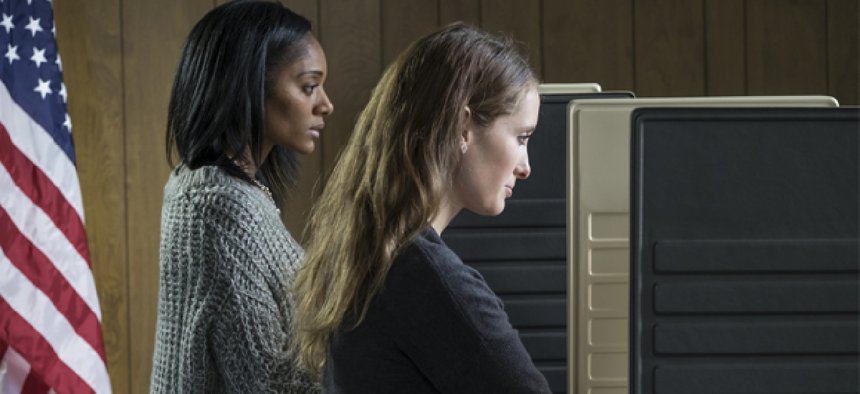Can open source and education save our electronic voting systems?


Connecting state and local government leaders
The future of online voting will depend on the federal government’s ability to work with states to enact uniform standards for voting protocols that include a verifiable voting method voters can trust.
With the recent disclosures of Democratic National Committee emails, allegations the election is rigged and other political machinations, conversations about the security of the general election are growing more frequent. People are asking, “How safe is my vote?”
It has become such an important issue that Department of Homeland Security Secretary Jeh Johnson discussed classifying election systems as critical infrastructure, entitling the states to the same level of cyber protection as the national power grid and the financial system. While classifying election infrastructure as critical may be a step in the right direction, it won’t be a cure-all for what ails us. To save our electronic voting system, we need to learn from the past to ready our systems for future demands.
The backstory
In 1990, the Federal Election Commission released the first standards for computer-based voting. Just 10 years later, problems with computer-based voting played a prominent role in the 2000 presidential election between George Bush and Al Gore, prompting the establishment of the Election Assistance Commission (EAC) and the Help America Vote Act “HAVA” to help states and localities upgrade their processes, tools and voting machines. Between April 2003 and December 2005, EAC distributed around $3 billion to the states to replace outdated voting machines with electronic voting systems.
The EAC developed a certification system for the electronic voting systems and provided guidance to election officials regarding the selection of systems. However, states have no constitutional requirements to abide by federal statute when it comes to the certification of machines, the transmission of information or the regularity with which voting machines are updated.
Now, on the eve of our fourth general election with these systems, most states and localities are struggling to find the spare parts, hardware and software necessary to keep all the machines in operation. The Brennan Center, a law and policy organization based at the New York University School of Law, estimates states and localities need to spend in excess of $1 billion to remediate and update current systems.
Many of the machines in service today use proprietary hardware and software and were primarily built on Windows XP. These systems’ vulnerabilities have been well publicized, including vendors that went out of business and operating systems that haven’t seen a security patch in two years. In short, we’re deciding the future of the free world with systems designed in the last century, being held together with duct tape and chewing gum. An exaggeration, but without addressing these outmoded machines, we’re at risk.
Looking ahead
Updating not only the systems but also the processes will be critical to stopping the constant development of new proprietary solutions. We must have more forethought in our design of these systems so they’re future-proofed.
In the immediate term, there are three areas to focus on:
Open source. Several localities -- such as Los Angeles County, Calif.; Travis County, Texas; and Denver County, Colo. -- are developing their own voting systems using open source software running on commercial off-the-shelf (COTS) tablets and printers. This system avoids expensive vendor “lock in” and allows more flexibility in both process and security.
Education. It shouldn’t be any surprise that humans continue to be the weakest link in cybersecurity. The government, through the EAC, has a role to play in cybersecurity education. Rather than reinvent the wheel, the EAC publishes best practices from states and localities on its website, providing guidelines and advice to states and to voting volunteers. More can always be done. What about a security road show for all volunteers? Public outreach and an educational media campaign before elections? Let’s see the government flex its education muscles to help create a savvier public.
A paper trail. In his 2016 Georgia Tech presentation, “Auditability and Verifiability of Elections,” MIT professor and renowned cryptographer Ronald Rivest describes an evidence-based election and argues that “trust me and my software” is not an appropriate strategy. “Trust but verify” is a better approach, and this thinking has led to the greater deployment of Direct Recording by Electronics systems with a “voter verified paper audit trail.” After all, with paper in addition to electronic data, an independent audit and recount are possible.
These three action items are a stop gap for addressing the most serious issues of the future of voting. How can we make voting more secure faster? By thinking about security in the same broad buckets as other systems:
- Security of the endpoint (paper ballot or voting machines)
- Security of data transmission (getting the paper into the ballot box or the vote from the voting machine to the counting machine)
- Security of the central systems (the independence of those counting the paper votes or the independence of the hardware and software of the counting machines)
- The design of the business process itself (ensuring that a vote for A means that a vote for A has been recorded)
It’s about taking a holistic approach to security from the booth to the endpoint, no matter its location. The future of online voting, even mobile voting, will depend on the federal government’s ability to work with states to enact uniform standards for voting protocols that include a verifiable voting method voters can trust. In the end, that’s what it comes down to -- a safe, secure, reliable system that is easy to access and that inspires voters with confidence that the system works.




